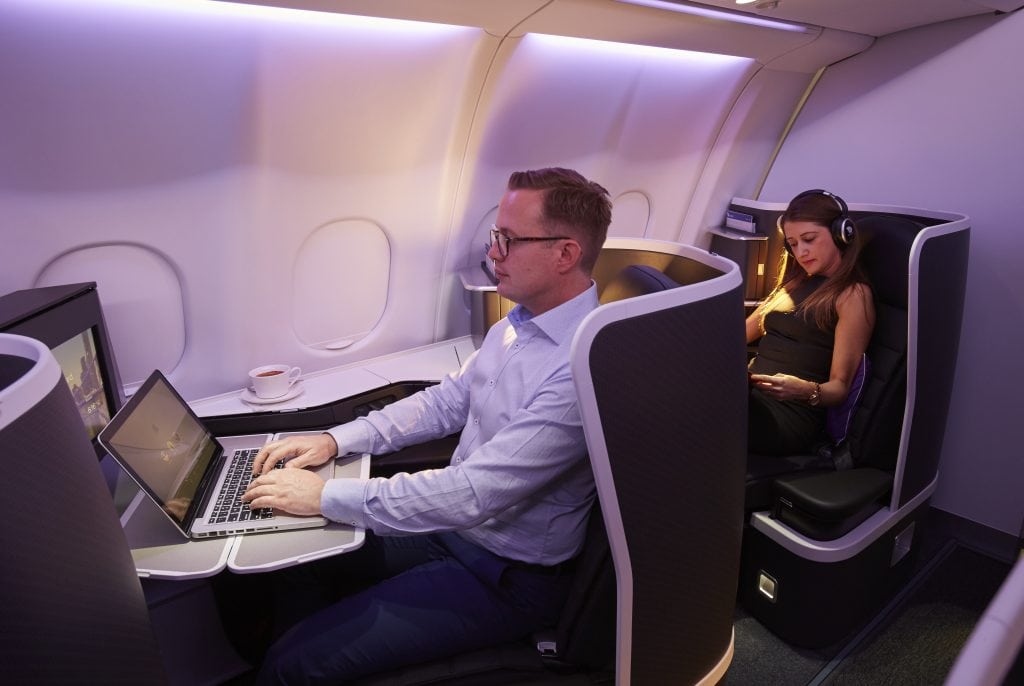Skift Take
Both Qantas and Virgin Australia should have Wi-Fi available on all domestic flights by the end of 2018. While travelers want to stay connected, they probably won’t pay for Wi-Fi, but might choose flights on the basis of internet coverage, especially on longer routes.
The race for in-flight Wi-Fi in Australia is heating up, with Qantas claiming an early win in the domestic stakes, while Virgin Australia has its nose in front on international services.
Both airlines are rolling out in-flight internet access, using different systems.
Having successfully trialled Wi-Fi on a Boeing 737, Virgin is first upgrading its 737 fleet before turning to its Boeing 777 aircraft.
“Domestically, three of our Boeing 737 aircraft are equipped with the technology and our guests are enjoying using the service free of charge. From (January), one aircraft every eight days will be fitted with in-flight Wi-Fi at our hangar in Brisbane, with the majority of the 737 fleet scheduled for completion by the end of this year,” a Virgin spokesperson said.
“Internationally, in-flight Wi-Fi is currently being tested on one of our five Virgin Boeing 777 aircraft and remains free of charge for all guests to use when flying across the Pacific. Installation in the entire Boeing 777 fleet is due for completion in May.”
Virgin’s in-flight connectivity is available in two speeds – standard and high speed, prompting speculation that customers will be asked to pay for faster connections.
Qantas, meanwhile, is also aiming to have its entire Australian fleet connected by the end of 2018, so far installing the technology on 20 Boeing 737 aircraft as part of a progressive roll-out. “While initially focusing on the 737 fleet, Qantas will shortly begin installation on domestic A330s, with 80 737 and A330 aircraft to be completed by the end of 2018,” a spokesperson confirmed.
Qantas claimed its system offers speeds up to 10 times faster than “conventional on-board Wi-Fi and gives customers the ability to stream movies, TV shows, music and news, including Netflix and Spotify.
On a special demonstration flight last year, Qantas Group CEO Alan Joyce said in-flight Wi-Fi had been on his wish list for quite a while, “but the sheer size of Australia meant it was hard to offer a service that was fast and reliable.”
Qantas has yet to announce its Wi-Fi intentions on its international services.
While Virgin has opted for service provider Gogo, which includes Delta Air Lines, Virgin Atlantic and British Airways among its customers, Qantas chose the local Australian National Broadband Network Sky Muster satellite network using ViaSat for its fleet.
“The technology we’re using … is a generation ahead of what most airlines around the world have and there’s a fair amount of complexity involved,” according to Joyce, who added that on flights between Melbourne, Sydney and Brisbane, where there is a high proportion of business travelers, the system should “get a real work-out with email and web browsing”.
Travel technology evangelist Johnny Thorsen, vice president of global travel strategy and partnerships at Mezi, Wi-Fi is clearly becoming a ‘must-have’ for any flight longer than one hour. “I know several travelers who will pick flights based on Wi-Fi being available or not,” he said, adding that he had “no doubt that Wi-Fi in the air “is here to stay and will be considered a given in the future.”
Travel agents aren’t yet seeing any shifts in customer behavior, mostly because neither major domestic carrier is guaranteeing Wi-Fi availability on their flights. However, many believe Wi-Fi access will impact customer choices when they become more accustomed to it, particularly on long flights such as Sydney-Perth, which approaches five hours.
Based on his observations of other markets, Mezi’s Thorsen believes that while business travelers may be prepared to pay for in-flight Wi-Fi, “leisure travelers generally avoid paying and therefore select flights with free Wi-Fi where it’s available.”
While Australia’s major carriers tackle the rollout of Wi-Fi, a technology actually developed Down Under, tech experts are looking to the next big thing. Thorsen, for example, expects that possibly as early as 2020, general cellphone services could be extended into an in-air mobile network.
“This technology will eventually become standard for all mobile subscribers, just like mobile data has become standard today on the ground,” he predicted.
The Daily Newsletter
Our daily coverage of the global travel industry. Written by editors and analysts from across Skift’s brands.
Have a confidential tip for Skift? Get in touch
Tags: australia, business travel, corporate travel, gateway, in-flight, virgin australia, wi-fi
Photo credit: Virgin Australia’s in-flight Wi-Fi system is being rolled out across the fleet. Virgin Australia
